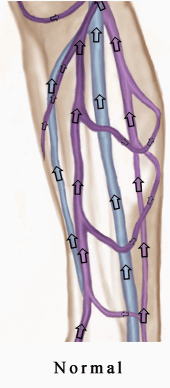Chronic Venostasis



Chronic venostasis, or chronic venous stasis, is a general non-specific term describing overall abnormal venous flow usually in the lower extremities. Chronic Venous Stasis is often used interchangeably with chronic venous insufficiency or distal venous vasculopathy or peripheral venous stasis disease, as well as many others.
Chronic Venous Stasis is less specific than venous edema. Yet, this term does not indicate either specific etiology or physiology of venous disease, as opposed to, for example, the term “superficial venous insufficiency”.
Overall, “chronic venostasis” or Chronic Venous Stasis is usually reserved for the abnormalities in venous circulation of the lower extremities, different from the venous insufficiency. Specifically, during the above venous insufficiency, the dilated blood vessels allow retrograde flow (flow in the reversed direction, away from the heart) of the venous blood. Venostasis or Venous Stasis, however, implies stagnant, but still antegrade venous flow (flow in the correct direction toward the heart), even though the blood in the affected vein is moving under higher than normal pressure. Chronic Venous Stasis, therefore, is more suitable for the description of abnormalities in the deep veins, since due to their muscular surroundings, they are unable to dilate. Furthermore, since chronic flow abnormalities caused by the prior deep venous thrombosis (DVT), are grouped under the term “post-thrombotic syndrome”, the term “venous stasis” describes pathological conditions caused by processes related to conditions other than DVT, and therefore, is an equivalent to the “secondary venous insufficiency”
New York Vein Treatment Center can help diagnose Chronic Venous Stasis and other circulation related conditions. We helped thousands of patients in the New York area. Contact us to schedule your consultation.
Start Your Journey To Feeling Good Again!
Schedule your Appointment Today with NYC's most Trusted and Comprehensive Vein Treatment Center

